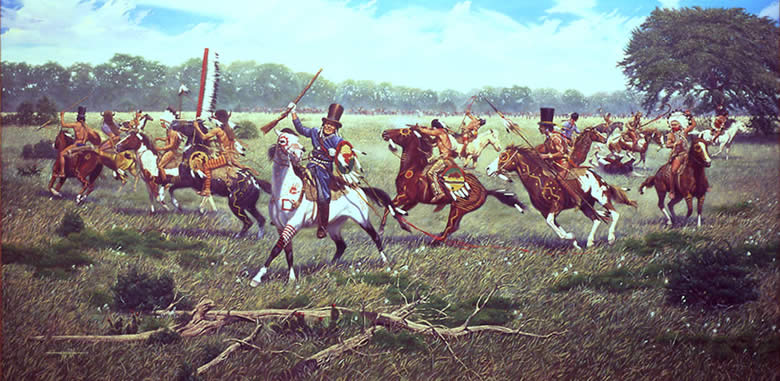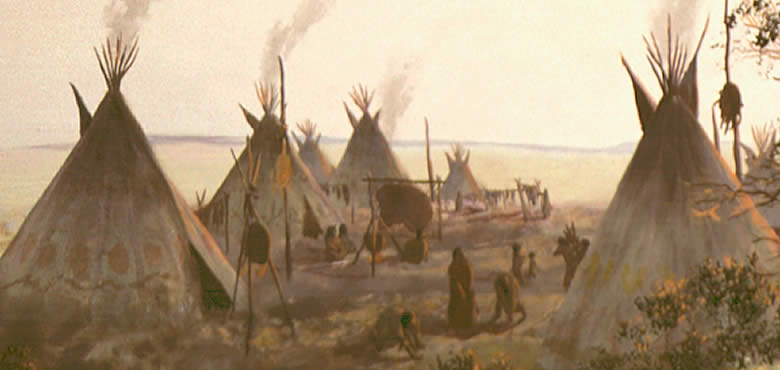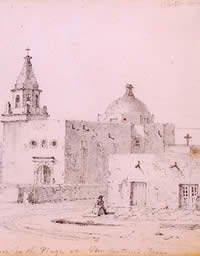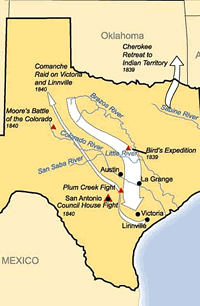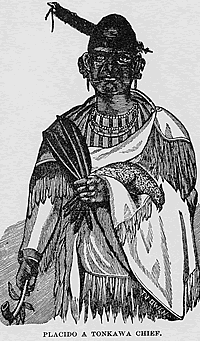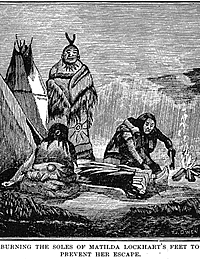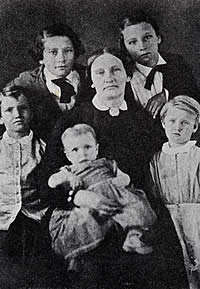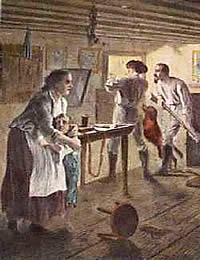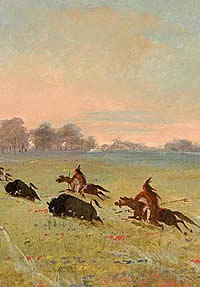
Comanche Indians Chasing Buffalo.
Detail of painting by George Catlin, (click image to
see entire painting).
|
|
Their time was finished. Now they, and their way,
would surrender to the dictates of the whites.
|
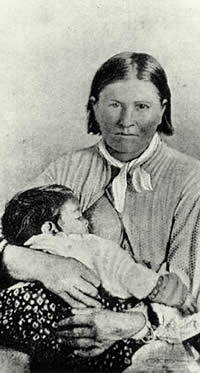
Cynthia Ann Parker, who was abducted
by Comanches in Ft. Parker, Texas, in 1836. Some 25
years later, with her hair cut short as a sign of mourning,
the mother of Quanah Parker was photographed after she
was involuntarily returned to white society. She is
shown holding daughter, Topsannah (Prairie Flower),
who was to die within the next year. Photo courtesy Denver Public Library, Western History Collection. Click for more
detail.
|
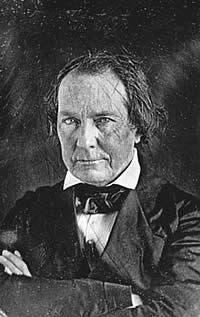
Mirabeau B. Lamar, second president
of the Texas Republic, overturned Sam Houston's more
lenient Indian policy with a more forceful one, aimed
at expelling all tribes from Texas. Image courtesy of
the San Jacinto Museum of History, Houston.
|
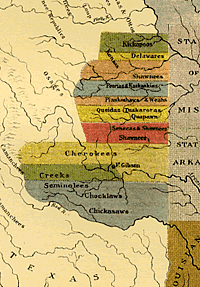
U.S. Indian frontier in 1840, showing
the positions of tribes that have been removed west
of the Mississippi. (Click for full image.) Painting
by George Catlin.
|
|
For longer than any Comanche could remember,
the summer had been a time of eager anticipation. It was the
time when preparations would begin for the great communal
bison hunts—when whole villages would pack their tipis,
ride out from the sheltering canyons of the Caprock, and find
the great beasts that sustained the Comanche way of life.
But not this time.
On June 2, 1875, the Quahadi chief Quanah Parker
led some 400 of the war-weary Comanche people into Fort Sill,
Indian Territory. This time, they carried only a few possessions
on their trek. This time, they would give up their weapons
and their remaining ponies. It was their last act as The People
they had been.
Their time was finished. Now they, and their
way, would surrender to the dictates of the whites. Now they
would hunt the bison only with permission, but even that time,
too, would soon be gone.
Quanah's life story has become the stuff of
Texas lore and legend. It begins in 1836 with the abduction
of Cynthia Ann Parker, the young white girl who would one
day become a Comanche wife and mother, who would later be
recaptured by Texas Rangers, and who would die hopeless, unable
either to see her Indian sons or to again become "white."
It ends in 1911 with Quanah Parker—wealthy rancher, successful
businessman, deputy sheriff—buried in full Comanche regalia.
Cynthia Ann would be reburied next to Quanah,
mother and son rejoined at last after more than 50 years.
But as its final irony, this essentially Texas story ends
in an Oklahoma cemetery. In the end, Texas would not be Indian
territory, not even for Quanah Parker.
The mythic dimensions of Quanah's story obscure
the hard reality of the war along the Texas frontier. It was
a conflict waged brutally and relentlessly, with "civilians"
on both sides targeted as readily as soldiers and warriors,
no quarter expected and none given. The pattern was already
taking form by the mid-1830s. The attack on the Parker family
compound left five white men dead, several women brutalized
and left for dead, two other young women and three children
carried away, among them Cynthia Ann, not yet a teenager.
The attack traumatized the Anglos, and galvanized
them as well. Mirabeau B. Lamar, second president of the Republic
of Texas, declared the policy of his administration in 1839.
"The white man and the red man cannot dwell in harmony
together," Lamar said. "Nature forbids it."
His solution was "to push a rigorous war against them;
pursuing them to their hiding places without mitigation or
compassion, until they shall be made to feel that flight from
our borders without hope of return, is preferable to the scourges
of war."
Lamar was the architect of the first Texas attempt to accomplish
what the government of the United States called "removal,"
the deportation of Indian tribes to places beyond the reach
of white settlers. As pursued by the United States, the policy
assumed there could be such a thing as a permanent Indian
frontier—a line beyond which the various "removed"
tribes would be able to carry on their lives free from white
encroachment.
The United States had removed some 50,000 Indians
from lands in the east to unorganized territory west of the
Mississippi River. This opened approximately 100 million acres
of eastern land to white settlement. To enforce the removal
and, in theory, to protect the Indians in their new lands,
a series of military posts was laid out on a roughly north-to-south
line from a point on the upper Mississippi in present Minnesota
to points near the Red River in present southeastern Oklahoma.
Unlike the U.S. government, however, Texas had
no lands it was willing to set aside for the Indians. In Lamar's
thinking, they would simply be driven beyond the Red River,
where they would become the problem and responsibility of
the United States.
To this end, John Henry Moore took a company
of about 60 settlers from the vicinity of LaGrange and in
January, 1839, rode up the Colorado River past its confluence
with the Llano to look for Comanches. Already a veteran of
more than 10 years of Texas frontier warfare, Moore included
in his force the Lipan chief Castro and a group of his warriors,
acting as scouts.
Moore led a dismounted attack into a surprised
Comanche camp near the San Saba River, where his men killed
a number of warriors in their teepees, and scattered the rest.
But the Comanches regrouped, stole the attackers' horses,
and escaped. The Lipans departed in disgust, leaving Moore
and his men to a dangerous retreat down the Colorado on foot.
|
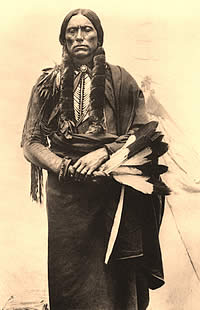
Quanah Parker, last war chief of
the Quahadi Comanche.
|
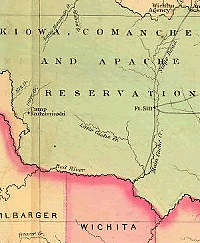
Map of Indian Territory, 1874, showing
reservation and Ft. Sill, Oklahoma. Click for full map.
Image courtesy of David Rumsey Collection.
|
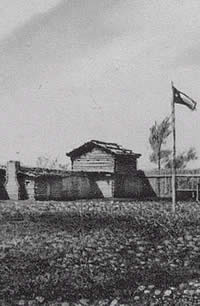
Fort Parker, a Limestone County compound
built by the Parker family for protection against the
Indians, was attacked in May 1836 by more than 500 Caddo
and Comanche Indians. Silas Parker was killed and five
individuals were captured, including 9-year-old Cynthia
Ann Parker. Click to enlarge.
|
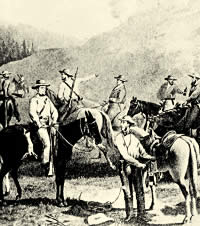
Volunteers mount up to search for Comanche raiders on
the frontier. These citizens and militia groups were the
forerunners of the Texas Rangers. Image courtesy Texas
State Library and Archives. |
|
The white man and the red man cannot dwell in harmony
together. Nature forbids it….
Mirabeau B. Lamar, 1839
|
|
